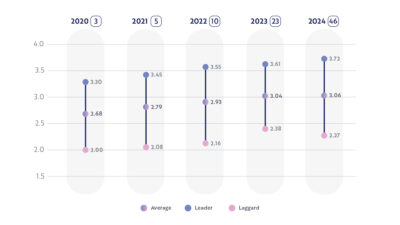
Many organizations launch their transformation journey with energy, ambition, and intent. The vision is bold. The budget is approved. The roadmap is printed.
But six months later?
Confusion creeps in.
Priorities drift.
Initiatives pile up.
Progress becomes a matter of opinion.
And leadership asks: “Are we still on track?”
That’s because transformation—unlike traditional projects—is dynamic, long-term, and multidimensional. It touches strategy, operations, culture, customer experience, and technology. And without a structured way to track progress, even the best-intentioned programs can lose their way.
This is where measurement becomes leadership’s best tool.
Because in transformation, assurance is everything.
Case Study: The Case for Control
One of our long-term clients, a global logistics firm with operations across Europe, Asia, and the Middle East, learned this the hard way.
Their digital transformation had started well—led by a respected CIO and fully endorsed by the board. They had launched a planning platform modernization, AI-driven routing optimization, and self-service tools for clients.
But by the second year, the cracks were showing:
- Business units were operating in silos again
- The project portfolio had ballooned to 60+ initiatives
- Transformation meetings became reporting exercises, not alignment sessions
No one could say with confidence: “Are we really making progress?”
That’s when they decided to move from ambition to assurance.
The Rhythm of Maturity
We introduced them to a concept that would change everything: regular, structured digital maturity measurement.
Every six months, the leadership team—including IT, operations, HR, finance, and business line leaders—would come together for a moderated self-assessment session using the Digital Maturity Index (DMI).
The first session revealed a score of 2.5 out of 5, with weaknesses in cultural adoption, process alignment, and cross-functional execution.
What followed was a two-year journey of rhythm, focus, and measurable improvement.
Their scores over time:
- Month 0: 2.5
- Month 6: 2.7
- Month 12: 2.9
- Month 18: 3.1
- Month 24: 3.3
But the real story is what happened between those numbers.
The Business Impact of Assurance
Each measurement cycle became a forcing function:
- A reason to bring all stakeholders back to the table
- A mirror to reflect on what was working—and what wasn’t
- A moment to re-prioritize and focus
Here are just a few outcomes of this regular cadence:
✔️ Initiative churn dropped by 40%
Projects that weren’t tied to strategic objectives were retired or merged. This freed up resources for high-priority initiatives, reducing waste and fatigue.
✔️ 12% improvement in operational efficiency
By focusing on process maturity in warehousing and transportation, automation initiatives gained traction and led to measurable gains in throughput and cost per shipment.
✔️ 41% increase in initiative completion rates
Leaders had clearer targets and timelines. Teams were more accountable. The visibility of maturity scores created positive pressure to deliver.
✔️ Real-time visibility through the Strategy Cockpit
Each DMI measurement was loaded into Digitopia’s platform—providing dashboards, benchmarks, and initiative tracking. Executives could now steer the transformation, not just observe it.
How Measurement Created Momentum
The leadership team didn’t wait for external consultants to tell them what to do. They built internal ownership.
Every DMI session was run by certified practitioners, but driven by the client’s own people. This ensured both credibility and commitment.
The act of measuring together became a cultural milestone.
Executives listened to each other.
Disagreements were aired and resolved.
Alignment was reinforced.
Every department saw where they stood—and what was expected of them.
By the third assessment, the conversation wasn’t “Why are we doing this?”
It was “How can we improve even more?”
Benchmarking as Strategic Pressure
Each time they measured, they also benchmarked against industry peers. That external comparison brought valuable context:
They saw they were ahead in AI pilots—but behind in cultural adoption.
They realized their operations were more mature than their customer experience.
They saw how top-quartile performers structured governance differently.
These insights sparked fresh initiatives and inspired internal teams to raise their game.
Benchmarks don’t just inform—they motivate.
And that motivation translated into faster decision-making and smarter investments.
Assurance for the Board
One of the most important outcomes?
Executive confidence.
The CIO no longer struggled to explain progress in abstract terms.
The CEO no longer relied on anecdotal updates.
The board received structured, visual, and comparative progress reports tied directly to strategy.
Digital maturity became a standing KPI—reviewed quarterly alongside revenue, EBITDA, and NPS.
And that visibility mattered.
It protected budgets.
It accelerated approvals.
It reinforced the importance of transformation across the organization.
A Model for the Future
After two years of steady progress, the company has now embedded maturity assessment into its annual planning cycle.
Every January, they assess.
Every March, they review and adjust initiatives.
Every June and November, they pulse-check progress.
And every December, they reflect, recalibrate, and recommit.
This isn’t just a process. It’s a discipline.
And it ensures that transformation doesn’t fade into the background—it stays at the center of strategy.
Want Progress You Can Actually See?
Make digital transformation measurable—and manageable. Our Digital Transformation solution helps you track maturity, benchmark progress, and turn strategy into sustained execution.
Why This Matters Now
In today’s business environment, everything moves fast.
AI is accelerating change.
Customers expect instant results.
Markets are volatile.
Talent is scarce.
And transformation fatigue is real.
In this context, assurance is not optional.
It’s the only way to stay in control.
To stay aligned.
To stay focused.
Because if you can’t measure your transformation, you can’t manage it.
If you can’t benchmark it, you can’t improve it.
And if you can’t visualize it, you can’t lead it.
What’s Measured Gets Done
This story of a logistics leader offers a simple but powerful message:
If you want to lead transformation—not just launch it—build the habit of measurement.
Start with a maturity assessment.
Do it with your people.
Repeat it regularly.
Benchmark against peers.
Use the insights to steer strategy.
And build a cockpit to track what matters most.
Because progress isn’t what you say—it’s what you can see.
And when everyone sees the same thing, real change happens.
Control isn’t a dream. It’s a discipline. And it starts with measuring maturity.




